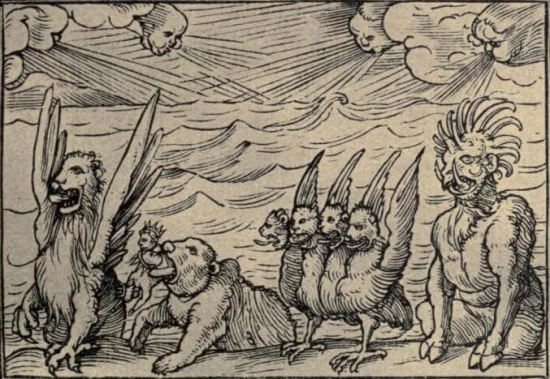1
ἔτος-N3E-GSN πρῶτος-A1--GSNS βασιλεύω-V1--PAPGSM *βαλτασαρ-N---GSM χώρα-N1A-GSF *βαβυλωνία-N1A-GSF *δανιηλ-N---NSM ὅραμα-N3M-ASN ὁράω-VBI-AAI3S παρά-P κεφαλή-N1--ASF ἐπί-P ὁ-
A--GSF κοίτη-N1--GSF αὐτός-
D--GSM τότε-D *δανιηλ-N---NSM ὁ-
A--ASN ὅραμα-N3M-ASN ὅς-
--ASN ὁράω-VBI-AAI3S γράφω-VAI-AAI3S εἰς-P κεφάλαιον-N2N-APN λόγος-N2--GPM
2
ἐπί-P ὁ-
A--GSF κοίτη-N1--GSF ἐγώ-
P--GS θεωρέω-V2I-IAI1S κατά-P ὕπνος-N2--APM νύξ-N3--GSF καί-C ἰδού-I τέσσαρες-A3--NPM ἄνεμος-N2--NPM ὁ-
A--GSM οὐρανός-N2--GSM ἐνπίπτω-VBI-AAI3P εἰς-P ὁ-
A--ASF θάλασσα-N1S-ASF ὁ-
A--ASF μέγας-A1--ASF
3
καί-C τέσσαρες-A3--NPN θηρίον-N2N-NPN ἀναβαίνω-V1I-IAI3P ἐκ-P ὁ-
A--GSF θάλασσα-N1S-GSF διαφέρω-V1--PAPNPN εἷς-A3--ASN παρά-P ὁ-
A--ASN εἷς-A3--ASN
4
ὁ-
A--NSN πρῶτος-A1--NSNS ὡσεί-D λέαινα-N1A-NSF ἔχω-V1--PAPNSF πτερόν-N2N-APN ὡσεί-D ἀετός-N2--GSM θεωρέω-V2I-IAI1S ἕως-P ὅστις-
X--GSN τίλλω-VBI-API3S ὁ-
A--NPN πτερόν-N2N-NPN αὐτός-
D--GSF καί-C αἴρω-VCI-API3S ἀπό-P ὁ-
A--GSF γῆ-N1--GSF καί-C ἐπί-P πούς-N3D-GPM ἀνθρώπινος-A1--GPM ἵστημι-VCI-API3S καί-C ἀνθρώπινος-A1--NSF καρδία-N1A-NSF δίδωμι-VCI-API3S αὐτός-
D--DSF
5
καί-C ἰδού-I μετά-P αὐτός-
D--ASF ἄλλος-
D--ASN θηρίον-N2N-ASN ὁμοίωσις-N3I-ASF ἔχω-V1--PAPASN ἄρκος-N2--GSM καί-C ἐπί-P ὁ-
A--GSN εἷς-A3--GSN πλευρόν-N2N-GSN ἵστημι-VCI-API3S καί-C τρεῖς-A3--NPN πλευρόν-N2N-NPN εἰμί-V9I-IAI3S ἐν-P ὁ-
A--DSN στόμα-N3M-DSN αὐτός-
D--GSF καί-C οὕτως-D εἶπον-VBI-AAI3S ἀναἵστημι-VH--AAD2S καταἐσθίω-VB--AAD2S σάρξ-N3K-APF πολύς-A1--APF
6
καί-C μετά-P οὗτος-
D--APN θεωρέω-V2I-IAI1S θηρίον-N2N-ASN ἄλλος-
D--ASN ὡσεί-D πάρδαλις-N3I-ASF καί-C πτερόν-N2N-NPN τέσσαρες-A3--NPN ἐπιτεινώ-V1--IAI3P ἐπάνω-P αὐτός-
D--GSN καί-C τέσσαρες-A3--NPF κεφαλή-N1--NPF ὁ-
A--DSN θηρίον-N2N-DSN καί-C γλῶσσα-N1S-NSF δίδωμι-VCI-API3S αὐτός-
D--DSN
7
μετά-P δέ-X οὗτος-
D--APN θεωρέω-V2I-IAI1S ἐν-P ὅραμα-N3M-DSN ὁ-
A--GSF νύξ-N3--GSF θηρίον-N2N-ASN τέταρτος-A1--ASN φοβερός-A1A-ASN καί-C ὁ-
A--NSM φόβος-N2--NSM αὐτός-
D--GSN ὑπερφέρω-V1--PAPNSM ἰσχύς-N3U-DSF ἔχω-V1--PAPASN ὀδούς-N3--APM σιδηροῦς-A1C-APM μέγας-A1--APM ἐσθίω-V1--PAPASN καί-C κοπανίζω-V1--PAPASN κύκλος-N2--DSM ὁ-
A--DPM πούς-N3D-DPM καταπατέω-V2--PAPASN διαφόρως-D χράομαι-V3--PMPASN παρά-P πᾶς-A3--APN ὁ-
A--APN πρό-P αὐτός-
D--GSN θηρίον-N2N-APN ἔχω-V1I-IAI3S δέ-X κέρας-N3T-APN δέκα-M
8
καί-C βουλή-N1--NPF πολύς-A1--NPF ἐν-P ὁ-
A--DPN κέρας-N3T-DPN αὐτός-
D--GSN καί-C ἰδού-I ἄλλος-
D--NSN εἷς-A3--NSN κέρας-N3T-NSN ἀναφύω-VDI-API3S ἀνά-P μέσος-A1--ASM αὐτός-
D--GPN μικρός-A1A-NSN ἐν-P ὁ-
A--DPN κέρας-N3T-DPN αὐτός-
D--GSN καί-C τρεῖς-A3--NPN ὁ-
A--GPN κέρας-N3T-GPN ὁ-
A--GPN πρῶτος-A1--GPNS ξηραίνω-VCI-API3P διά-P αὐτός-
D--GSN καί-C ἰδού-I ὀφθαλμός-N2--NPM ὥσπερ-D ὀφθαλμός-N2--NPM ἀνθρώπινος-A1--NPM ἐν-P ὁ-
A--DSN κέρας-N3T-DSN οὗτος-
D--DSN καί-C στόμα-N3M-NSN λαλέω-V2--PAPNSN μέγας-A1--APN καί-C ποιέω-V2I-IAI3S πόλεμος-N2--ASM πρός-P ὁ-
A--APM ἅγιος-A1A-APM
9
θεωρέω-V2I-IAI1S ἕως-C ὅτε-D θρόνος-N2--NPM τίθημι-VCI-API3P καί-C παλαιός-A1A-NSM ἡμέρα-N1A-GPF καταἧμαι-V1I-IMI3S ἔχω-V1--PAPNSM περιβολή-N1--ASF ὡσεί-D χιών-N3N-ASF καί-C ὁ-
A--ASN τρίχωμα-N3M-ASN ὁ-
A--GSF κεφαλή-N1--GSF αὐτός-
D--GSM ὡσεί-D ἔριον-N2N-NSN λευκός-A1--NSN καθαρός-A1A-NSN ὁ-
A--NSM θρόνος-N2--NSM ὡσεί-D φλόξ-N3G-NSF πῦρ-N3--GSN
10
καί-C ἐκπορεύομαι-V1I-IMI3S κατά-P πρόσωπον-N2N-ASN αὐτός-
D--GSM ποταμός-N2--NSM πῦρ-N3--GSN χίλιοι-A1A-NPF χιλιάς-N3D-NPF θεραπεύω-V1I-IAI3P αὐτός-
D--ASM καί-C μύριοι-A1A-NPF μυριάς-N3D-NPF παραἵστημι-VXI-YAI3P αὐτός-
D--DSM καί-C κριτήριον-N2N-NSN καταἵζω-VAI-AAI3S καί-C βίβλος-N2--NPF ἀναοἴγω-VQI-API3P
11
θεωρέω-V2I-IAI1S τότε-D ὁ-
A--ASF φωνή-N1--ASF ὁ-
A--GPM λόγος-N2--GPM ὁ-
A--GPM μέγας-A1--GPM ὅς-
--GPM ὁ-
A--NSN κέρας-N3T-NSN λαλέω-V2I-IAI3S καί-C ἀποτυμπανίζω-VSI-API3S ὁ-
A--NSN θηρίον-N2N-NSN καί-C ἀποὀλλύω-VBI-AMI3S ὁ-
A--NSN σῶμα-N3M-NSN αὐτός-
D--GSN καί-C δίδωμι-VCI-API3S εἰς-P καῦσις-N3I-ASF πῦρ-N3--GSN
12
καί-C ὁ-
A--APM κύκλος-N2--DSM αὐτός-
D--GSN ἀποἵστημι-VAI-AAI3S ὁ-
A--GSF ἐξουσία-N1A-GSF αὐτός-
D--GPN καί-C χρόνος-N2--NSM ζωή-N1--GSF δίδωμι-VCI-API3S αὐτός-
D--DPN ἕως-P χρόνος-N2--GSM καί-C καιρός-N2--GSM
13
θεωρέω-V2I-IAI1S ἐν-P ὅραμα-N3M-DSN ὁ-
A--GSF νύξ-N3--GSF καί-C ἰδού-I ἐπί-P ὁ-
A--GPF νεφέλη-N1--GPF ὁ-
A--GSM οὐρανός-N2--GSM ὡς-C υἱός-N2--NSM ἄνθρωπος-N2--GSM ἔρχομαι-V1I-IMI3S καί-C ὡς-C παλαιός-A1A-NSM ἡμέρα-N1A-GPF παραεἰμί-V9--IAI3S καί-C ὁ-
A--NPM παραἵστημι-VXI-XAPNPM παραεἰμί-V9--IAI3P αὐτός-
D--DSM
14
καί-C δίδωμι-VCI-API3S αὐτός-
D--DSM ἐξουσία-N1A-NSF καί-C πᾶς-A3--NPN ὁ-
A--NPN ἔθνος-N3E-NPN ὁ-
A--GSF γῆ-N1--GSF κατά-P γένος-N3E-APN καί-C πᾶς-A1S-NSF δόξα-N1S-NSF αὐτός-
D--DSM λατρεύω-V1--PAPNSF καί-C ὁ-
A--NSF ἐξουσία-N1A-NSF αὐτός-
D--GSM ἐξουσία-N1A-NSF αἰώνιος-A1B-NSF ὅστις-
X--NSF οὐ-D μή-D αἴρω-VC--APS3S καί-C ὁ-
A--NSF βασιλεία-N1A-NSF αὐτός-
D--GSM ὅστις-
X--NSF οὐ-D μή-D φθείρω-VD--APS3S
15
καί-C ἀκηδιάω-VA--AAPNSM ἐγώ-
P--NS *δανιηλ-N---NSM ἐν-P οὗτος-
D--DPN ἐν-P ὁ-
A--DSN ὅραμα-N3M-DSN ὁ-
A--GSF νύξ-N3--GSF
16
προςἔρχομαι-VBI-AAI1S πρός-P εἷς-A3--ASM ὁ-
A--GPM ἵστημι-VXI-XAPGPM καί-C ὁ-
A--ASF ἀκρίβεια-N1A-ASF ζητέω-V2I-IAI1S παρά-P αὐτός-
D--GSM ὑπέρ-P πᾶς-A3--GPN οὗτος-
D--GPN ἀποκρίνω-VC--APPNSM δέ-X λέγω-V1--PAI3S ἐγώ-
P--DS καί-C ὁ-
A--ASF κρίσις-N3I-ASF ὁ-
A--GPM λόγος-N2--GPM δηλόω-VAI-AAI3S ἐγώ-
P--DS
17
οὗτος-
D--NPN ὁ-
A--NPN θηρίον-N2N-NPN ὁ-
A--NPN μέγας-A1--APN εἰμί-V9--PAI3P τέσσαρες-A3--NPM βασιλεία-N1A-NPF ὅς-
--NPF ἀποὀλλύω-VF2-FMI3P ἀπό-P ὁ-
A--GSF γῆ-N1--GSF
18
καί-C παραλαμβάνω-VF--FMI3P ὁ-
A--ASF βασιλεία-N1A-ASF ἅγιος-A1A-NPM ὕψιστος-A1--GSM καί-C καταἔχω-VF--FAI3P ὁ-
A--ASF βασιλεία-N1A-ASF ἕως-P ὁ-
A--GSM αἰών-N3W-GSM καί-C ἕως-P ὁ-
A--GSM αἰών-N3W-GSM ὁ-
A--GPM αἰών-N3W-GPM
19
τότε-D θέλω-V1I-IAI1S ἐκἀκριβάζομαι-VC--AMN περί-P ὁ-
A--GSN θηρίον-N2N-GSN ὁ-
A--GSN τέταρτος-A1--GSN ὁ-
A--GSN διαφθείρω-V1--PAPGSN πᾶς-A3--APN καί-C ὑπερφόβος-A1B-GSN καί-C ἰδού-I ὁ-
A--NPM ὀδούς-N3--NPM αὐτός-
D--GSN σιδηροῦς-A1C-NPM καί-C ὁ-
A--NPM ὄνυξ-N3--NPM αὐτός-
D--GSN χαλκοῦς-A1C-NPM καταεσθίω-V1--PAPNPM πᾶς-A3--APM κυκλόθεν-D καί-C καταπατέω-V2--PAPNPM ὁ-
A--DPM πούς-N3D-DPM
20
καί-C περί-P ὁ-
A--GPN δέκα-M κέρας-N3T-GPN αὐτός-
D--GSN ὁ-
A--GPN ἐπί-P ὁ-
A--GSF κεφαλή-N1--GSF καί-C ὁ-
A--GSN εἷς-A3--GSN ὁ-
A--GSN ἄλλος-
D--GSN ὁ-
A--GSN προςφύω-V1--PAPGSN καί-C ἐκπίπτω-VAI-AAI3P διά-P αὐτός-
D--GSN τρεῖς-A3--NPN καί-C ὁ-
A--NSN κέρας-N3T-NSN ἐκεῖνος-
D--NSN ἔχω-V1I-IAI3S ὀφθαλμός-N2--APM καί-C στόμα-N3M-ASN λαλέω-V2--PAPASN μέγας-A1--APN καί-C ὁ-
A--NSF πρόσοψις-N3I-NSF αὐτός-
D--GSN ὑπερφέρω-V1I-IAI3S ὁ-
A--APN ἄλλος-A1--APN
21
καί-C κατανοέω-V2I-IAI1S ὁ-
A--ASN κέρας-N3T-ASN ἐκεῖνος-
D--ASN πόλεμος-N2--ASM συνἵστημι-V6--PMPASN πρός-P ὁ-
A--APM ἅγιος-A1A-APM καί-C τροπόω-V4--PAPASN αὐτός-
D--APM
22
ἕως-P ὁ-
A--GSN ἔρχομαι-VB--AAN ὁ-
A--ASM παλαιός-A1A-ASM ἡμέρα-N1A-GPF καί-C ὁ-
A--ASF κρίσις-N3I-ASF δίδωμι-VAI-AAI3S ὁ-
A--DPM ἅγιος-A1A-DPM ὁ-
A--GSM ὕψιστος-A1--GSM καί-C ὁ-
A--NSM καιρός-N2--NSM δίδωμι-VCI-API3S καί-C ὁ-
A--ASN βασίλειον-N2N-ASN καταἔχω-VBI-AAI3P ὁ-
A--NPM ἅγιος-A1A-NPM
23
καί-C εἶπον-VCI-API3S ἐγώ-
P--DS περί-P ὁ-
A--GSN θηρίον-N2N-GSN ὁ-
A--GSN τέταρτος-A1--GSN ὅτι-C βασιλεία-N1A-NSF τέταρτος-A1--NSF εἰμί-VF--FMI3S ἐπί-P ὁ-
A--GSF γῆ-N1--GSF ὅστις-
X--NSF διαφέρω-VF--FAI3S παρά-P πᾶς-A1S-ASF ὁ-
A--ASF γῆ-N1--ASF καί-C ἀναστατόω-VF--FAI3S αὐτός-
D--ASF καί-C καταλεαίνω-VF2-FAI3S αὐτός-
D--ASF
24
καί-C ὁ-
A--NPN δέκα-M κέρας-N3T-NPN ὁ-
A--GSF βασιλεία-N1A-GSF δέκα-M βασιλεύς-N3V-NPM ἵστημι-VF--FMI3P καί-C ὁ-
A--NSM ἄλλος-
D--NSM βασιλεύς-N3V-NSM μετά-P οὗτος-
D--APM ἵστημι-VF--FMI3S καί-C αὐτός-
D--NSM διαφέρω-VF--FAI3S κακός-A1--DPN ὑπέρ-P ὁ-
A--APM πρῶτος-A1--APMS καί-C τρεῖς-A3--APM βασιλεύς-N3V-APM ταπεινόω-VF--FAI3S
25
καί-C ῥῆμα-N3M-APN εἰς-P ὁ-
A--ASM ὕψιστος-A1--ASM λαλέω-VF--FAI3S καί-C ὁ-
A--APM ἅγιος-A1A-APM ὁ-
A--GSM ὕψιστος-A1--GSM κατατρίβω-VF--FAI3S καί-C προςδέχομαι-VF--FMI3S ἀλλοιόω-VA--AAN καιρός-N2--APM καί-C νόμος-N2--ASM καί-C παραδίδωμι-VC--FPI3S πᾶς-A3--APN εἰς-P ὁ-
A--APF χείρ-N3--APF αὐτός-
D--GSM ἕως-P καιρός-N2--GSM καί-C καιρός-N2--GPM καί-C ἕως-P ἥμισυς-A3U-GSM καιρός-N2--GSM
26
καί-C ὁ-
A--NSF κρίσις-N3I-NSF καταἵζω-VF--FMI3S καί-C ὁ-
A--ASF ἐξουσία-N1A-ASF ἀποὀλλύω-VF2-FAI3P καί-C βουλεύω-VF--FMI3P μιαίνω-VA--AAN καί-C ἀποὀλλύω-VA--AAN ἕως-P τέλος-N3E-GSN
27
καί-C ὁ-
A--ASF βασιλεία-N1A-ASF καί-C ὁ-
A--ASF ἐξουσία-N1A-ASF καί-C ὁ-
A--ASF μεγαλειότης-N3T-ASF αὐτός-
D--GPM καί-C ὁ-
A--ASF ἀρχή-N1--ASF πᾶς-A1S-GPF ὁ-
A--GPF ὑπό-P ὁ-
A--ASM οὐρανός-N2--ASM βασιλεία-N1A-GPF δίδωμι-VAI-AAI3S λαός-N2--DSM ἅγιος-A1A-DSM ὕψιστος-A1--GSM βασιλεύω-VA--AAN βασιλεία-N1A-ASF αἰώνιος-A1B-ASF καί-C πᾶς-A1S-NPF ὁ-
A--NPF ἐξουσία-N1A-NPF αὐτός-
D--DSM ὑποτάσσω-VD--FPI3P καί-C πειθαρχέω-VF--FAI3P αὐτός-
D--DSM
28
ἕως-P καταστροφή-N1--GSF ὁ-
A--GSM λόγος-N2--GSM ἐγώ-
P--NS *δανιηλ-N---NSM σφόδρα-D ἔκστασις-N3I-DSF περιἔχω-V1I-IMI1S καί-C ὁ-
A--NSF ἕξις-N3I-NSF ἐγώ-
P--GS διαφέρω-VAI-AAI3S ἐγώ-
P--DS καί-C ὁ-
A--ASN ῥῆμα-N3M-ASN ἐν-P καρδία-N1A-DSF ἐγώ-
P--GS στηρίζω-VAI-AAI1S







